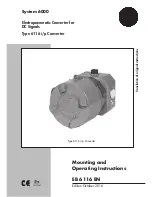
6
3.
INSTALLATION
3.1 POWER SOURCE REQUIREMENTS
The power source must provide between 11 and 14.5 volts DC and must
be able to supply the necessary current to operate the load. The power
source may be a battery or a well-regulated DC power supply. To obtain
a rough estimate of the current (in amperes) the power source must
deliver, simply divide the power consumption of the load (in watts AC)
by 10.
Example: If a load is rated at 400 watts AC, the power source must be
able to deliver:
400
÷
10 = 40 amperes
CAUTION:
The Power-On-Board™ 400 must be connected only to
batteries with a nominal output voltage of 12 volts. The unit will not
operate from a 6 volt battery and will sustain permanent damage if
connected to a 24 volt battery.
3.2 CONNECTION TO POWER SOURCE
The Power-On-Board™ 400 comes equipped with a cigarette lighter
plug and battery clip cables for connection to the power source:
CAUTION:
Do not use with positive ground electrical systems. (the
majority of modern automobiles, RVs, and trucks are negative ground)
Connecting to Power Source Using Cigarette Lighter Plug:
The cigarette lighter plug is suitable for operating the inverter at power
outputs up to 150 watts. The tip of the plug is positive and the side
contact is negative. Connect the Power-On-Board 400 to the power source
by inserting the cigarette lighter plug firmly into the cigarette lighter
socket of a vehicle or other DC power source.
CAUTION:
Connect directly to power source when operating above
150 Watts.
NOTE:
Most automobile cigarette lighter circuits use fuses rated at 15
to 20 Amps or greater. To operate at full 400 watts output, either use
the battery clip cable (supplied) or directly wire to the power source
with user supplied wire and fuse.


































